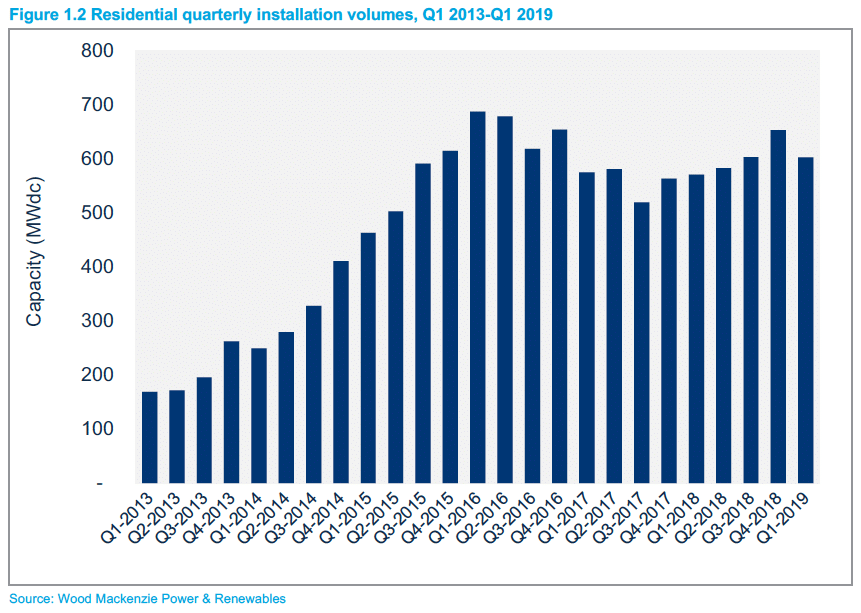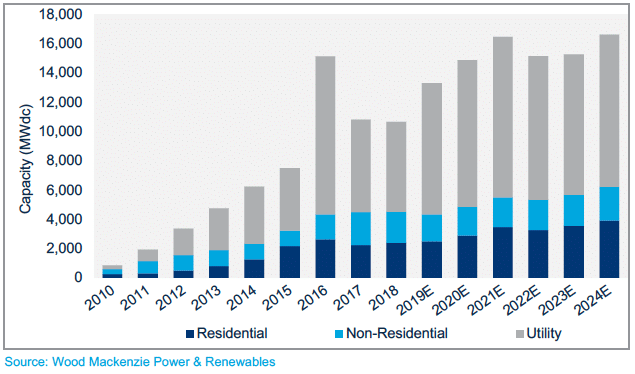From pv magazine USA.
California has always been top dog in terms of U.S. solar and record headlines. Every quarter, the Golden State has topped rankings and the questions were only ever how much bigger California would be than rival markets, and which states would come in second and third.
But this year marks a departure from that path. According to the latest numbers in the quarterly Solar Energy Industries Association/Wood Mackenzie Power & Renewables Solar Market Insight report, a whopping 860 MWdc was installed in Florida in Q1, compared to California’s 538 MW – the first time since 2012 any state has bettered California on a quarterly basis.

That is stunning growth for Florida, which saw very little activity as recently as a few years ago. Even in 2017 and 2018, Florida’s solar market was less than a third the size of California’s. The state has now installed in one quarter more than it did in either year.
A lot of the activity comes from the state’s largest utility, Florida Power & Light, which has launched a program to install 30 million solar panels – more than 10 GW of capacity – by 2030.
Residential market recovery
The push by Florida plus a relatively normal quarter for California led to the largest volume of new U.S. solar capacity deployed in any first quarter to date – 2.7 GWdc, 10% more than the same period of last year. That was composed of a recovery in the residential market as well as healthy utility scale additions.
The period marked the third consecutive quarter with more than 600 MW of residential solar added for what Wood Mackenzie described as the continuation of a “modest rebound” from the slide of 2016 and 2017.
Popular content

Wood Mackenzie suggested the market is adopting a “more sustainable growth profile” but noted a lot of the progress is due to emerging state markets – including Florida – and that states with high penetration rates are struggling with high customer acquisition costs.
Rising expectations
Wood Mackenzie raised its 2019 forecast to more than 13 GWdc, growth of 25% on 2018 levels and an increase of 1.2 GW from its previous forecast. Based on the interconnection queues of grid operators, construction starts and other sources, pv magazine had already stated the consultant’s earlier forecast would prove too conservative.
WoodMac credited the rise to progress in Texas, offering further evidence diversification is driving growth in the U.S. solar market. Over the next five years the firm expects Florida to be the largest market for utility scale solar with California to retain its overall lead due to more robust residential and commercial and industrial segments.
Wood Mackenzie expects the U.S. market to grow over the next two years to more than 16 GWdc in 2021 after the hangover in 2017 following 2016’s boom, and market disruption in 2018 caused by Section 201 tariffs. Time will tell if the consultancy’s forecast again proves conservative, given the ongoing fall in system prices and the fact more states, cities and utilities are committing to 100% clean energy. The rush to get projects online in advance of the expiration of the Investment Tax Credit is another factor in solar’s favor.

And there is one more data point that suggests an upside to the WoodMac numbers: the 27.7 GWdc of solar projects that currently hold power purchase agreements, including 4.7 GW that are under construction.
This content is protected by copyright and may not be reused. If you want to cooperate with us and would like to reuse some of our content, please contact: editors@pv-magazine.com.


3 comments
By submitting this form you agree to pv magazine using your data for the purposes of publishing your comment.
Your personal data will only be disclosed or otherwise transmitted to third parties for the purposes of spam filtering or if this is necessary for technical maintenance of the website. Any other transfer to third parties will not take place unless this is justified on the basis of applicable data protection regulations or if pv magazine is legally obliged to do so.
You may revoke this consent at any time with effect for the future, in which case your personal data will be deleted immediately. Otherwise, your data will be deleted if pv magazine has processed your request or the purpose of data storage is fulfilled.
Further information on data privacy can be found in our Data Protection Policy.